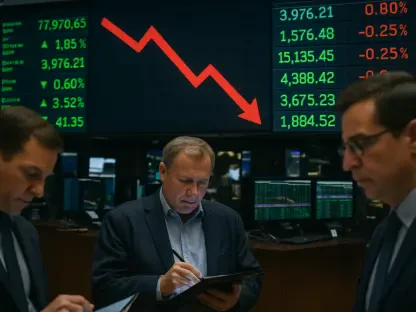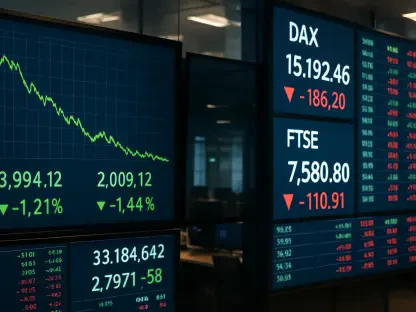In the heart of the desert, the Greater Phoenix housing market is carving out a remarkable story of growth and resilience, standing tall against a backdrop of underwhelming national figures. Data from Phoenix REALTORS® paints a vivid picture of a region—spanning cities like Scottsdale, Mesa, and Goodyear—that’s not just keeping pace but surging ahead in critical areas such as closed sales, new listings, and median home prices. Year-to-date closed sales have climbed by 3.8% compared to last year, with a striking 4.9% increase in October alone, dwarfing the national growth rate of 1.5% for the same period. This robust performance, coupled with an 8% rise in new listings against a national decline of 0.8%, signals a market brimming with confidence and demand. As national trends falter, Phoenix emerges as a beacon of stability and opportunity, prompting a closer examination of the forces driving this exceptional trajectory and what it means for buyers, sellers, and the broader real estate landscape.
Key Drivers Behind Phoenix’s Strength
Robust Sales and Listings Growth
The foundation of Phoenix’s standout performance lies in its consistent ability to outpace national benchmarks in sales and listings activity. While the country grapples with a staggering 27.1% drop in pending sales, Greater Phoenix has managed a modest but telling 0.5% increase, reflecting a steady stream of buyer interest. This divergence highlights a local economy bolstered by strong fundamentals, including population growth and job opportunities that continue to draw residents to the area. The 3.8% year-to-date rise in closed sales, paired with a significant uptick in new listings, suggests that sellers remain confident in the market’s strength, further fueling transaction volumes. This momentum stands in stark contrast to national sluggishness, positioning Phoenix as a hub of real estate activity that defies broader economic headwinds.
Beyond the raw numbers, the growth in sales and listings points to a deeper resilience within the Phoenix metro area. Unlike many regions where uncertainty has dampened market dynamics, local conditions have fostered an environment where both buyers and sellers feel encouraged to engage. The 4.9% spike in closed sales for October alone underscores a market that’s not merely holding steady but actively accelerating. This sustained activity, especially against a backdrop of national declines, suggests that Phoenix benefits from unique demand drivers, possibly tied to its appeal as a destination for relocation and investment. Such trends indicate a market poised for continued strength, even as other areas struggle to regain footing.
Stable Prices and Rising Affordability
Another pillar of Phoenix’s market strength is the delicate balance between stable home prices and improving affordability. Median home prices in Greater Phoenix have inched up by 0.4%, aligning with the national average of $480,000, which supports homeowner equity without pricing out potential buyers. Simultaneously, the affordability index has improved from 69 to 71, meaning 71% of households can now afford a median-priced home—a 2.9% gain from the prior year. This rare combination reflects a market that caters to a wide range of buyers while maintaining value for current owners. As noted by Christy Walker, board president of Phoenix REALTORS®, rising household incomes play a pivotal role in sustaining this balance, ensuring that economic growth translates into tangible housing access.
This stability in pricing, coupled with affordability gains, sets Phoenix apart from regions where skyrocketing costs have eroded buyer confidence. The slight uptick in median prices signals a healthy appreciation that benefits sellers, yet it remains moderate enough to keep the market accessible. The affordability improvement, driven by income growth, suggests that more families and individuals are finding opportunities to enter homeownership, a trend that bodes well for long-term demand. Unlike national markets where affordability often lags behind price increases, Phoenix demonstrates a synchronized progress that nurtures both buyer interest and seller returns. This equilibrium is a key reason the region continues to attract attention from across the country.
Regional Variations Shaping the Market
Contrasting Trends Across Cities
Diving into the Phoenix metro area reveals a tapestry of diverse market conditions, where each city contributes a unique thread to the broader narrative. In the City of Phoenix, inventory remains relatively tight at a 3.8-month supply, with closed sales growing by a modest 1.8%, yet days on the market have stretched by 20% to 66 days, hinting at a slower pace. Meanwhile, Mesa grapples with a notable 28.3% increase in days on the market to 68 days, though it still outperforms the regional average. Gilbert, on the other hand, boasts an 8.2% surge in closed sales and a tight 3-month inventory, reflecting robust activity despite longer sales cycles. These disparities underscore how localized factors—such as demographic shifts and housing stock—shape distinct outcomes within the same metropolitan region.
Further exploration of these variations highlights the complexity of navigating the Phoenix market. Scottsdale’s high-end segment, with median prices rising 3.5% to $1.18 million and closed sales up 5.7%, showcases strength in luxury real estate, contrasting with more affordable areas like Surprise, where days on the market hit 80 despite a 6.1% rise in closed sales. This patchwork of performance means that strategies for buying or selling must be tailored to specific locales. For instance, tighter inventory in Gilbert may favor sellers, while longer sales timelines in Mesa could empower buyers to negotiate. Understanding these nuances is critical for stakeholders aiming to capitalize on the region’s overall strength, as opportunities and challenges differ markedly from one city to the next.
Standout Performers and Challenges
Among the standout performers, Goodyear emerges as a powerhouse with a remarkable 27.2% surge in closed sales and a 24.4% jump in pending sales, though its median price saw a slight 1.2% dip to $475,000. This burst of activity signals intense demand in the area, potentially driven by new developments and infrastructure growth. In contrast, Peoria shows more tempered progress with a 5.6% increase in closed sales but a 1.5% drop in median price to $529,000, alongside a 20% rise in days on the market to 72 days. These mixed results reflect the varied pace of growth across the region, where certain areas race ahead while others face hurdles in maintaining price stability or sales velocity, offering a spectrum of investment prospects.
Challenges persist even among stronger markets, as seen in Surprise, where inventory supply grew by 23.1% to 4.8 months and days on the market increased by 9.6% to 80 days, despite solid gains in sales activity. This lengthening of sales cycles, mirrored in many cities, suggests a cooling of the frenetic pace that once defined the region, potentially due to buyer caution or increased selectivity amid growing inventory. Yet, cities like Goodyear demonstrate that explosive growth remains possible, highlighting the potential for targeted opportunities. These contrasting dynamics emphasize the importance of localized analysis—while the broader Phoenix area thrives, individual cities navigate their own paths, presenting both risks and rewards for market participants.
Market Balance and Future Implications
Shift Toward a Balanced Market
A notable trend shaping Greater Phoenix is the gradual shift toward a more balanced housing market, driven by rising inventory and extended sales timelines. Inventory levels across the region have increased by 19.2%, resulting in a 4.4-month supply, while average days on the market have climbed by 15.6% to 74 days. Although most areas still fall below the 5- to 6-month threshold that typically defines a balanced market, this growth in supply offers buyers more options and breathing room compared to the intense seller’s market of recent years. This evolution suggests a maturing market where competition may ease, potentially reducing the pressure on buyers while still providing favorable conditions for sellers in many locales.
This shift also reflects broader changes in buyer behavior and market dynamics within Phoenix. The lengthening days on the market indicate that buyers are taking more time to make decisions, possibly due to the wider array of choices or a cautious approach amid economic uncertainties. While still leaning toward sellers, the increased inventory signals a departure from the scarcity-driven frenzy of the past, hinting at a future where negotiations could play a larger role. For sellers, this means adapting to a landscape where strategic pricing and patience may become more critical. As the market inches closer to balance, stakeholders must monitor these trends to anticipate how they might reshape opportunities in the coming months.
Sustained Optimism for Phoenix’s Horizon
Looking back, the journey of the Greater Phoenix housing market revealed a region that consistently outperformed national declines, with robust sales growth and stable prices marking a path of resilience. The optimism expressed by industry leaders like Christy Walker proved well-founded, as the market balanced rising affordability with steady home values. Moving forward, the focus should shift to leveraging this strength through targeted strategies—buyers can capitalize on growing inventory to secure favorable deals, while sellers might consider localized pricing tactics to stand out in slower-moving cities. As inventory trends suggest a tilt toward balance, staying attuned to regional variations will be key. Phoenix stands poised to maintain its edge, offering a dynamic arena for real estate engagement in the months ahead.









